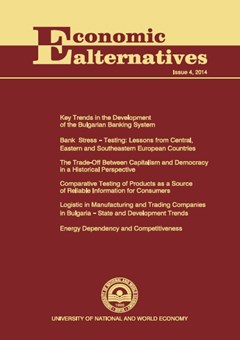Key Trends in the Development of the Bulgarian Banking System between the Two World Wars
Author: Ekaterina Sotirova
Abstract
The development of the Bulgarian banking system is a specific process which reflects both the state of the economy as a whole and the financial sector in particular. The system was shaped in the years after the First World War. After the war, the entire development of the country’s economy, including that of the banking system, was largely affected by the fact that Bulgaria had lost the war. BNB was in charge of the payment of the post-war reparations. The bank introduced the so called gold-currency standard – the lev was backed by both gold and foreign currency. Prof. Alexander Tsankov’s government introduced a state monopoly on currency trade (1923). By the beginning of the 1929/1933 crisis the lending system in the country was built and complete. The broad picture showed that there was long-term capital insufficiency in Bulgaria. There were a few big loans – the Bulgarian national loan (1921), the Stabilisation loan (1928) and Redemption Bank bonds. The lending activity in the country and that of the BNB were closely related to foreign loans such as the Refugee loan (1926) and the Stabilisation loan (1928). A law on BNB was passed in 1928, which stipulated that it became a full-bodied issuance institution. The law was also an attempt to establish the bank’s independence from the government. The commercial banks responded to the 1929/33 crisis through consolidation. In 1929 there were 137 banks, in 1934 – 118 and in 1935 their number fell to 99. BNB’s intervention, which involved refinancing the ailing banks, turned out to be of crucial importance to the stability of the banking system. The economic crisis resulted in very high indebtedness of agricultural businesses. The state attempted to curb that negative trend and adopted a Law on the protection of agricultural producers (1932). Redemption bank at the Government debts Directorate was founded. One of the strongest banks in the 1930s was Bulgarian Credit bank. The cooperative companies became more active in banking during that period. Typical characteristic features of the Bulgarian banking system during the 1930s until the start of the Second World War are: stronger centralization, industry concentration, the growing importance of both the public lending institutions and of the big Bulgarian commercial banks, the increased circulation of banknotes and of the financial aid provided to the government by BNB.

